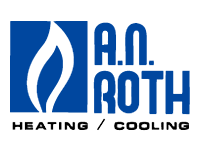As the temperature drops, the discomfort level at home often rises. Icy floors mean slippers are a must. The coziest spots in the house are inevitably near the heating vents. (If you know, you know!) Radiant heating, however, can eliminate uncomfortably cold floors, cool patches, and uneven temperatures. We asked A.N. Roth’s General Manager Richard Roth for a deep dive into the benefits of radiant heating and here’s what he had to say…
How exactly does radiant heating work?
Most radiant heat systems are floor systems using hot-water tubes or electric wires to directly heat the floor from below. The heat coming from the heating system warms the floor’s surface, which make the floor a heat emitter. There are three common types of radiant floor systems. In-slab consists of tubing or wires imbedded directly in the concrete slab. Over-floor features tubing or wires between the subfloor and the finished floor. Finally, underfloor involves tubing or wires below the subfloor itself. Which option works best depends on the age of the home, the overall home design, and many other factors.
What are some of the other benefits of radiant heating beyond keeping the floor warmer?
There are lots of benefits to this kind of system. It’s much more efficient than forced-air because it eliminates the loss of air from ducts. Underfloor systems typically use less electricity as well, saving up to 15% on energy bills. Another benefit is a boost to air quality. Radiant heat does not recirculate dust and allergens like traditional heating methods do.
Are there radiant heating options other than underfloor systems?
Yes, alternatives to radiant floors are radiant walls and ceilings. It’s the same basic concept with wires and tubing but concealed in the walls or ceiling. Radiant ceilings perform very well because the surface temperature can run hotter due to the increased heat tolerance of sheetrock compared to typical flooring materials. Sheetrock also tends to heat up faster than flooring, not to mention people don’t cover their ceilings with furniture or rugs so overall there’s an increased efficiency. The same can be said of radiant heating in walls, except that homeowners need to be careful when hanging art or other items that might hinder the effectiveness of the system.
Can radiant heating be retrofitted into existing homes and buildings?
Yes. Though it is most easily installed in new construction projects, it’s possible to add it to older structures. For floors, having access to the underside of the subfloor through an unfinished basement makes things simpler. Or as mentioned before, there are options for installing it above the subfloor, beneath finished flooring like tile, vinyl, wood or even carpet. For ceiling and wall retrofits, it’s required to gain access behind the drywall to add the proper plates or piping. If a homeowner is considering radiant heat, we’re always happy to come out to take a look and determine the best option for the situation.
If you have any other questions about radiant heating or any other issue related to your home’s heating and air conditioning system, call A. N. Roth at 502.584.8502 or contact us today.


